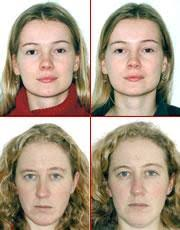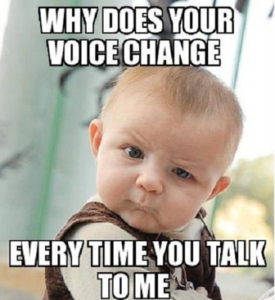By Sarah Raines, Ryan Casey, Tori Blair, and Chasity Ramsey
Fellas, have you noticed that you find your girl to be more attractive at certain times in comparison to other times? Ladies, do you occasionally find that your man seems to be overly drawn to you more than usual? If you answered “yes” to one of the questions above, you aren’t alone. It might surprise you to learn that this “yes” speaks to research supporting the hypothesis that men have evolved the ability to detect and respond to different cues of ovulation
Ovulation and Evolution
Ovulation occurs when an egg is fully matured and released from the ovaries to be fertilized by sperm. This normally happens once per month, about midway between your last and next period, and it is only in the days surrounding this event that it is possible to get pregnant.
Ladies, how many of you know for certain when you’re ovulating? If you’re like many women, you may not be sure. So, if you don’t know when you’re ovulating, how could ovulation possibly impact your behavior, or your partner’s perception of you? As it turns out, neither women nor men need to know when someone is ovulating in order for ovulation to matter. There is a possibility that you do not know when you are ovulating because you do not notice when your body is going through its hormonal changes, but it is, and those fluctuations have noticeable effects–if you know where to look.
Unlike humans, some female animals show obvious signs when they are in “heat” and ready to look for a sexual partner. This is known as Estrus or Oestrus. Sheep, lions, dogs, baboons, and other animals all show signs of being in heat when they are ready to mate. Some of these animals’ butts turn red when they are in “heat” and that lets other animals know that

they are “ready for action”. Not all animals have pair-bonding between mates so they encourage male conflicts and competitions to determine who they will mate with.
So, why don’t humans have these more obvious signs of fertility? One possibility is that it’s due to the highly social nature of our species. Concealed ovulation in humans has opened the door for stronger pair-bonding. For instance, in some species, males and females only affiliate with each other when it’s time to mate–the rest of the time, they do their own thing. But in other species, like ours, male-female bonds are longer-lasting. Concealed ovulation might promote these longer bonds because neither partner “knows” when sex will lead to a fertilization, and so they have sex across the cycle. Stronger pair-bonding would increase male investment and it could also increase male-male cooperation. It also helps prevent men from fighting with one another for women in estrus. (Besides, I am sure you ladies wouldn’t want to walk around with bright red butts to attract men, would you?)
There have been researchers who hypothesized that ovulation was concealed in humans because it helps women and men form long-term relationships that would reduce men’s chances of looking for another mate. This would have benefits for both men and women: women would receive more investment from men to help care for their children, and it would also cause men to have higher confidence levels of paternity, because they would be with their female partners across the cycle–which leads into our next question.

Why would men need to detect cues to ovulation?
Ancestral men who could identify and attract women who were high in fertility gained more reproductive success over men who were unable to detect fertility. So not knowing when females are ovulating may have decreased the likelihood of our male ancestors of having offspring because they couldn’t respond to females obvious oestrus cues that signal when women are most fertile. This suggests that there would have been an advantage for men who could detect subtle cues that women were ovulating. In other words, if the subtle shifts that women go through during ovulation caused some men to find then more sexually attractive, these men would have been more likely to father children, and would have passed the genes for these preferences on to modern humans.

What are the subtle cues to ovulation in humans?
Clothing Choices
Ladies, imagine you are going out for a night on the town and you need to get dressed. What are you mostly likely to choose right now? Shorts and a low cut shirt or skinny jeans with a nice shirt? Maybe a short dress with some high heels or a long flowy sun dress? According to some research, your answer might depend on whether you’re ovulating. According to Kristina Durante’s study on sexual cues during ovulation, women who are ovulating are much more likely to choose shorts and a low cut shirt or a short dress with high heels than the more conservative clothing.
We also see that both men and women are able to notice this shift. In an evaluation done using pictures of women, 94% of women and 86% of men correctly chose the woman who was closer to ovulating; under the only criteria of, who looks more attractive? This subtle “cue” can show men that you are sexually available, mature or just have a simple ability to reproduce.
Facial Changes
Another study that discusses attractiveness is from Roberts et al. and it states that women’s facial attractiveness may vary and change over the course of their ovulation cycle. The article suggests that the visible cues to human female ovulation are primarily in the face and that this paired with other topics discussed in this post will pair nicely to make our cycles less cryptic or hidden. The results of their study showed that facial attractiveness does vary throughout the ovulation cycle and it can be seen by both men and women. The changes to the face that can be seen, are often clearer skin or a subtle redness to the face, often called a blush.

When looking at the picture to the right, which do you find to be more attractive? If you chose the two left versions then you picked the two that are ovulating. The change that is seen in the pictures are subtle and caused the effect to be minimal. Although, according to researchers, with other “cues,” changes in the face may be significant enough to show ovulation. Note that such possible attractive facial cue features are dilation of the pupils, both the size and color of lips, and skin color and tone.
Though both of the above studies suggest visual cues to female ovulation, there are other subtler cues, such as smells and voice changes, that suggest ovulation.
Vocal Attractiveness
There are some existing studies on the singing voice changing throughout the ovulation cycle, but in the study discussed here the researchers carried out a review of six different English studies on the same subject and came to the conclusion that because of hormone changes during ovulation, the voice can vary in volume and pitch, which does cause a slight voice change throughout the ovulation process.
A study that tested if women’s voices changed found that men prefer higher pitched voices rather than lower pitched voices. They also found that when women are ovulating, they speak with a higher pitched tone. This cue to ovulation has been shown in few studies, but it does show that men can hear a difference in pitch and that that difference can make a woman more attractive.

The Scent of a Woman
Smell is a strong sense. It is said smells are the fastest way to transport us back to memories. But can we as humans smell ovulation? If you aren’t convinced that behaviors are different when ovulating, there is even more evidence ovulating woman actually smell different to men than non-ovulating women–and furthermore, there’s evidence that this detection influences testosterone levels. Testosterone can cause many changes in males, whether there is a large increase or a small one there can be many differences. Innately, the testosterone levels in a man can increase when doing nothing but smelling women’s shirts. Seems strange, but true, and there is more! Not only did the testosterone levels increase when sniffing shirts worn during ovulation, but decreased when sniffing the shirts worn by non-ovulating women.

So why is this increase in testosterone beneficial? Increasing testosterone in males has been linked to an increase in sex drive and overall desire. Therefore, an increase in testosterone when smelling a shirt is a great cue to the innate changes that occur in men when a woman ovulates. This is yet more evidence that evolution is pointing men in ways where ovulation can be pinpointed.
Pretty cool evidence, no? But there are other ways that future research endeavors can provide evidence for men having evolved to detect and respond to cues of ovulation.
Takeaways
Okay, so here’s what we covered!
- Women’s dress, facial appearance, perhaps voice pitch, and smell seem to serve as cues of ovulation for men.
- Fluctuations in testosterone as a result of smell seem to be indicators of men’s ability to detect of ovulation.
- Evolving to pick up on these proposed ovulatory cues increased our male ancestors’ likelihood of having offspring and, therefore, they past those abilities onto us.
And now that we’ve got that covered, here’s what future research can do to add to the body of evidence behind men evolving to detect ovulation.
What’s next? Future Research Directions for Ovulation
Since women express a preference for clothing that will draw more attention or is less conservative, researchers could have women come in at ovulating and non-ovulating times to try on an assortment of more or less conservative outfits. This would strengthen research because women trying on outfits would mean that their final choice in outfits would most likely result in how the outfits make them feel at low and high fertility times.
Expanding on the above, it speaks to the second study mentioned in which participants reported on how much the women cared about being perceived attractively. Researchers could compare the reports on how the outfits make women feel to the ratings done by those indicating how attractive the women want to appear.
Reflecting back to the study in which participants noted the change in women’s faces at ovulating and non-ovulating times, in order to strengthen these findings, it would be good if future researchers had women come in to have photographs taken over the course of several ovulating and non-ovulating times and be able to expose the judging participants to several versus two pictures of women.
Now, for the changes in voice pitch that women seem to undergo at ovulation, the best case for strengthening the evidence here is for researchers to look for voice pitch changes and men’s attraction to it in multiple contexts. Findings from multiple contexts would be good because a smaller likelihood of factors potentially characteristic of just a few contexts would be affecting the overall body of evidence.

And the same is probably true for strengthening the evidence behind men picking up smell as a sign of ovulation. In other words, why not have men smell women’s jeans, bras, or even hair accessories such as headbands?
And what about a study that represents ovulation cues being detected over time? Researchers could administer weekly email questionnaires to men to report on attraction to their wives/cohabitating partners. The types of questions asked of participants would inevitably relate to actions/behaviors (e.g. choice in dress and so forth) and voice and smell.
Well, that’s all folks!
Bet you’ll never look at an attractively dressed woman quite the same as you once did before.